An avant-garde fantasy epic, with spectacular visuals and the usp of a landscape printing format; Echolands has a lot to set it apart from the other titles on the comic shelf. At time of writing, only the first 6 issues of W Haden Blackman and J H Williams’ series have been released, with the true history of the titular Echolands still to be fully unravelled, but the story so far has gotten off to a spectacular start.

The Echolands themselves are a fantastical mish-mash of every conceivable genre of pulp fiction, a dystopian melting pot of fairy tale, noir, western, sci-fi, anime, pirate swashbuckler, gothic horror and silver-age super-hero. The main storyline is effectively an extended chase through this patchwork land, as a disparate band of outcasts and their defacto leader Rose are pursued by the fascist authorities, attempting to recover a mysterious pendant which Rose has come into possession of. Blackman and Williams’ plotting keeps things interesting through branching subplots within the main comic itself, and supplemented by ‘interview’ sections with the villainous autocrat Teros Demond, serialised at the end of each issue (similar to the supporting material that Alan Moore created for the seminal Watchmen series).

The main attractions though, are J H Williams’ visuals. The artist has already established a reputation on celebrated titles such as Prometheus and Batwoman for spectacular page design and ornate double-page spreads. He levels-up on Echolands by opting for a landscape page format, so that his double-page compositions now span across over four times the width of a regular comic. It makes for a truly widescreen reading experience, and also serves the kinetic nature of the plot well, with action fluidly running across the page from left to right without interruption.

Inadvertently (or possibly on purpose), the landscape format also makes this comic a uniquely material reading experience. The extended spreads are not easily compatible with the aspect ratio of a reading device screen, and would require a greater amount of zooming and scrolling to fully appreciate in digital form. A further throwbacks to the golden days of print comics are that Williams illustrates each of the characters in the specific style of their respective genre; eg. there are visual cues to Jack Kirby’s super heroes, Michael Moorcock’s elves, Chester Gould’s gangsters and Bernie Wrightson’s zombies.

And although it’s not explicit within the plot, I can’t help but feel that music was a strong influence on the creators. At the end of each issue, Williams publishes a comprehensive playlist of the records (largely vinyl lp’s) that he has been listening too while working on that issue’s art. It’s no coincidence then, that his storytelling pulses with the energy and layering of a punk or new-wave floor filler, and that his rebellious heroine Rose is the spitting image of late 70’s era Debbie Harry. Much like the tangible experience of handling a record onto a player, Echolands is a work that’s absorbed as much through your fingertips as through your eyeballs.

